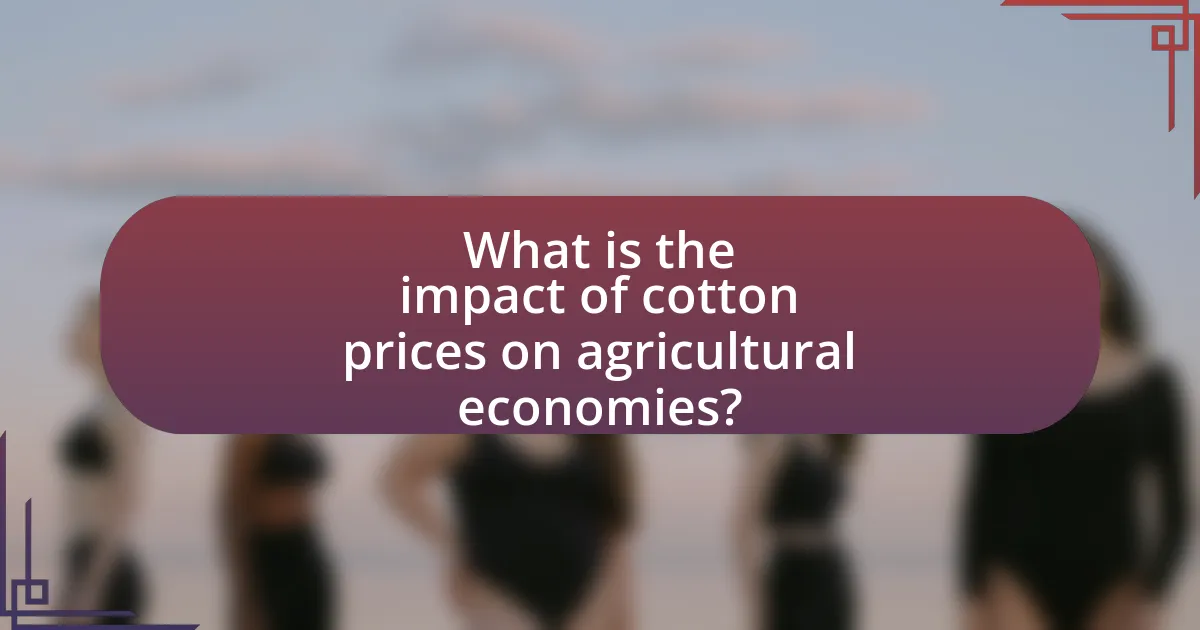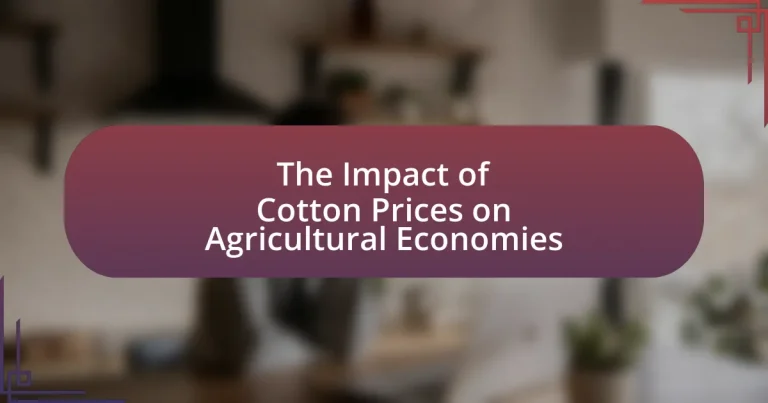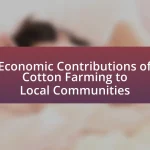Cotton prices play a crucial role in shaping agricultural economies by directly influencing farmers’ income, production decisions, and overall economic stability in cotton-dependent regions. Fluctuations in cotton prices can lead to significant changes in farmers’ revenue, impacting their ability to invest in sustainable practices and affecting rural employment rates. The article examines the short-term and long-term effects of cotton price changes, the implications for crop diversification, and the socio-economic consequences for communities reliant on cotton production. Additionally, it explores global factors, trade policies, and climate change’s impact on cotton pricing, as well as strategies farmers can adopt to mitigate risks associated with price volatility.

What is the impact of cotton prices on agricultural economies?
Cotton prices significantly influence agricultural economies by affecting farmers’ income and production decisions. When cotton prices rise, farmers are incentivized to increase cotton production, leading to higher agricultural output and potentially boosting local economies. Conversely, falling cotton prices can result in reduced income for farmers, leading to lower investment in agricultural practices and a decline in overall economic activity in cotton-dependent regions. For instance, in countries like India and the United States, fluctuations in cotton prices have historically impacted rural employment rates and the financial stability of farming communities, demonstrating the direct correlation between cotton pricing and agricultural economic health.
How do fluctuations in cotton prices affect farmers’ income?
Fluctuations in cotton prices significantly impact farmers’ income by directly influencing their revenue from cotton sales. When cotton prices rise, farmers experience increased income, allowing them to invest in better farming practices and equipment. Conversely, when prices fall, farmers face reduced income, which can lead to financial instability and difficulty in covering production costs. For instance, a study by the Food and Agriculture Organization (FAO) indicated that a 10% decrease in cotton prices could lead to a 20% reduction in farmers’ net income, highlighting the sensitivity of farmers’ earnings to price changes.
What are the short-term effects of rising cotton prices on farmers?
Rising cotton prices have immediate positive effects on farmers by increasing their revenue per unit of cotton sold. This increase in income can lead to enhanced cash flow, allowing farmers to invest in better equipment, seeds, and farming practices. For instance, a 2021 report from the U.S. Department of Agriculture indicated that a 10% rise in cotton prices could boost farmers’ income significantly, enabling them to cover operational costs more effectively. Additionally, higher prices may incentivize farmers to increase production, potentially leading to short-term overproduction if prices stabilize or decline afterward.
How do falling cotton prices influence farmers’ long-term sustainability?
Falling cotton prices negatively influence farmers’ long-term sustainability by reducing their income and financial stability. When cotton prices decline, farmers experience lower revenue, which can lead to decreased investment in essential resources such as seeds, fertilizers, and equipment. According to a study by the Food and Agriculture Organization, a 10% drop in cotton prices can result in a 20% reduction in farmers’ net income, making it challenging for them to maintain sustainable farming practices. This financial strain can force farmers to adopt short-term strategies, such as cutting costs on sustainable practices, which ultimately undermines their long-term viability and environmental stewardship.
What role do cotton prices play in the overall agricultural market?
Cotton prices significantly influence the overall agricultural market by affecting the income of farmers and the pricing of related agricultural products. When cotton prices rise, farmers experience increased revenue, which can lead to higher investments in other crops and agricultural inputs. Conversely, declining cotton prices can result in reduced income for farmers, potentially leading to lower production levels and impacting the supply chain. For instance, in 2021, cotton prices surged to a decade-high of over $1.50 per pound, which positively impacted the earnings of cotton-producing regions and stimulated economic activity in those areas. This relationship underscores the interconnectedness of cotton prices with broader agricultural economic dynamics.
How do cotton prices compare to other agricultural commodities?
Cotton prices are generally lower than those of high-value agricultural commodities like soybeans and corn, but they can fluctuate significantly based on market conditions. For instance, as of 2023, cotton prices averaged around $1.10 per pound, while soybean prices were approximately $14 per bushel and corn prices hovered around $6 per bushel. This price disparity reflects the varying demand and supply dynamics in the agricultural market, where cotton is often influenced by textile industry trends, whereas soybeans and corn are driven by food and biofuel demands.
What are the implications of cotton price changes on crop diversification?
Cotton price changes significantly influence crop diversification decisions among farmers. When cotton prices rise, farmers are incentivized to allocate more land and resources to cotton production, often at the expense of other crops, leading to reduced diversification. Conversely, when cotton prices fall, farmers may seek to diversify their crops to mitigate financial risks, opting for alternative crops that may offer better returns or stability. Historical data indicates that in regions like the U.S. South, fluctuations in cotton prices have led to shifts in crop planting patterns, with a notable increase in soybean and corn cultivation during periods of low cotton prices. This dynamic illustrates the direct relationship between cotton pricing and the agricultural choices made by farmers, impacting overall agricultural sustainability and economic resilience.
Why are cotton prices significant for rural economies?
Cotton prices are significant for rural economies because they directly influence the income of farmers and the overall economic stability of agricultural communities. In many rural areas, cotton is a primary cash crop, and fluctuations in its market price can determine the financial viability of farming operations. For instance, a study by the Food and Agriculture Organization indicates that a 10% increase in cotton prices can lead to a 5% rise in rural household incomes, highlighting the crop’s critical role in economic health. Additionally, higher cotton prices can stimulate local economies by increasing demand for related services and goods, such as equipment and labor, thereby creating jobs and enhancing livelihoods in rural regions.
How do cotton prices impact employment in rural areas?
Cotton prices significantly impact employment in rural areas by directly influencing the income of farmers and agricultural workers. When cotton prices are high, farmers experience increased revenues, which often leads to higher employment levels as they expand operations and hire more laborers for planting, harvesting, and processing. Conversely, low cotton prices can result in reduced income, prompting farmers to cut back on labor costs, leading to job losses and decreased employment opportunities in these communities. For instance, a study by the International Cotton Advisory Committee found that a 10% increase in cotton prices can lead to a 5% increase in rural employment in cotton-dependent regions, highlighting the direct correlation between cotton market fluctuations and rural job availability.
What are the socio-economic effects of cotton price volatility on communities?
Cotton price volatility significantly affects communities by disrupting income stability and economic planning. When cotton prices fluctuate, farmers experience uncertainty in their earnings, which can lead to reduced investment in agricultural inputs and lower productivity. For instance, a study by the International Cotton Advisory Committee found that a 10% drop in cotton prices can lead to a 5% decrease in farmers’ income, impacting their ability to support their families and invest in education and healthcare. Additionally, communities reliant on cotton production may face increased poverty levels and reduced access to essential services, as families struggle to cope with the financial instability caused by price swings. This volatility can also lead to broader economic repercussions, such as job losses in related sectors like textile manufacturing and trade, further exacerbating socio-economic challenges within these communities.

How do global factors influence cotton prices?
Global factors significantly influence cotton prices through supply and demand dynamics, trade policies, and climatic conditions. For instance, fluctuations in global demand for cotton, driven by the textile industry, can lead to price increases or decreases. Additionally, trade policies, such as tariffs and export restrictions imposed by major cotton-producing countries like the United States and India, directly affect market accessibility and pricing. Furthermore, adverse weather events, such as droughts or floods in key cotton-growing regions, can disrupt supply chains, leading to scarcity and higher prices. Historical data shows that in 2010, severe droughts in Texas contributed to a spike in cotton prices, reaching over $2 per pound, illustrating the direct impact of global factors on market prices.
What international market trends affect cotton pricing?
International market trends that affect cotton pricing include global supply and demand dynamics, trade policies, and currency fluctuations. For instance, an increase in cotton production in major exporting countries like the United States and India can lead to lower prices due to oversupply. Conversely, rising demand from countries such as China can drive prices up. Additionally, trade policies, such as tariffs or trade agreements, can significantly impact cotton prices by altering market access and competitiveness. Currency fluctuations also play a crucial role; a stronger U.S. dollar can make cotton more expensive for foreign buyers, potentially reducing demand and affecting pricing. These trends are supported by data from the U.S. Department of Agriculture, which regularly reports on global cotton production and consumption statistics.
How do trade policies impact cotton prices globally?
Trade policies significantly influence global cotton prices by affecting supply and demand dynamics. For instance, tariffs imposed on cotton imports can increase prices in importing countries by raising costs for manufacturers, which may lead to reduced consumption. Conversely, subsidies for cotton production in exporting countries can lower their prices, making it difficult for producers in other nations to compete. According to the World Bank, changes in trade agreements, such as the U.S.-China trade tensions, have led to fluctuations in cotton prices, impacting global markets and agricultural economies reliant on cotton production.
What role does climate change play in cotton price fluctuations?
Climate change significantly influences cotton price fluctuations by affecting crop yields and production stability. Increased temperatures, altered precipitation patterns, and extreme weather events can lead to reduced cotton production, which in turn drives prices higher due to lower supply. For instance, the National Cotton Council reported that drought conditions in key cotton-producing regions can lead to yield reductions of up to 30%, directly impacting market prices. Additionally, climate change can shift planting seasons and increase pest pressures, further destabilizing cotton supply and contributing to price volatility.
How do currency exchange rates affect cotton prices?
Currency exchange rates significantly influence cotton prices by affecting the cost of imports and exports. When a country’s currency strengthens against others, its cotton becomes more expensive for foreign buyers, potentially reducing demand and lowering prices. Conversely, if the currency weakens, cotton becomes cheaper for international markets, increasing demand and potentially raising prices. For instance, in 2021, the U.S. dollar’s strength led to a decrease in U.S. cotton exports, contributing to a decline in domestic cotton prices. This relationship illustrates how fluctuations in currency values can directly impact the agricultural economy, particularly in commodity markets like cotton.
What is the relationship between the US dollar and cotton prices?
The relationship between the US dollar and cotton prices is inversely correlated; as the value of the US dollar increases, cotton prices typically decrease, and vice versa. This occurs because cotton is traded globally in US dollars, meaning that a stronger dollar makes cotton more expensive for foreign buyers, reducing demand and subsequently lowering prices. For example, in 2021, when the US dollar strengthened against other currencies, cotton prices fell from approximately $0.90 per pound to around $0.70 per pound, illustrating this inverse relationship.
How do local currencies impact cotton export competitiveness?
Local currencies significantly impact cotton export competitiveness by influencing the pricing and profitability of cotton in international markets. When a country’s local currency depreciates against major currencies like the US dollar, the price of its cotton becomes cheaper for foreign buyers, potentially increasing demand and boosting export volumes. For instance, a 10% depreciation of the local currency can lead to a corresponding increase in export competitiveness, as seen in countries like India, where currency fluctuations have historically affected cotton exports. Conversely, if the local currency appreciates, cotton prices in foreign markets rise, which can reduce demand and negatively impact export competitiveness. This relationship underscores the importance of currency stability and exchange rates in determining the success of cotton exports in the global market.
What are the effects of supply chain disruptions on cotton prices?
Supply chain disruptions lead to increased cotton prices due to reduced availability and higher transportation costs. For instance, events like natural disasters or geopolitical tensions can hinder the movement of cotton from producers to markets, resulting in scarcity. According to the USDA, a 10% decrease in supply can lead to a price increase of approximately 20% in the cotton market. Additionally, logistical challenges can inflate shipping costs, further driving up prices. These factors collectively impact agricultural economies reliant on cotton, as higher prices can reduce demand and affect overall market stability.
How do transportation costs influence cotton pricing?
Transportation costs significantly influence cotton pricing by affecting the overall cost structure of cotton supply chains. When transportation expenses rise, they increase the final price of cotton for consumers, as producers must pass on these costs to maintain profitability. For instance, a study by the USDA in 2021 indicated that transportation costs can account for up to 20% of the total cost of cotton production and distribution. This relationship means that fluctuations in fuel prices or shipping rates directly impact cotton market prices, influencing both domestic and international trade dynamics.
What impact do geopolitical tensions have on cotton supply and prices?
Geopolitical tensions significantly disrupt cotton supply and elevate prices. For instance, conflicts in major cotton-producing regions, such as the United States, China, and India, can lead to trade restrictions, reduced exports, and supply chain disruptions. In 2021, the U.S. cotton exports faced challenges due to tensions with China, which resulted in increased prices due to anticipated shortages. Additionally, geopolitical instability can lead to speculative trading, further driving up prices as investors react to perceived risks in supply continuity. Historical data shows that during periods of heightened geopolitical conflict, cotton prices have often surged, reflecting the market’s sensitivity to supply chain vulnerabilities.

What strategies can farmers adopt to mitigate the impact of cotton price fluctuations?
Farmers can adopt several strategies to mitigate the impact of cotton price fluctuations, including diversifying crops, implementing forward contracting, and utilizing risk management tools such as options and futures. Diversifying crops allows farmers to reduce reliance on cotton alone, thereby spreading financial risk across multiple sources of income. Forward contracting enables farmers to lock in prices for their cotton before harvest, providing price certainty and protecting against market downturns. Additionally, using options and futures contracts can help farmers hedge against price volatility by allowing them to set prices in advance or protect against adverse price movements. These strategies are supported by research indicating that diversified farming systems can enhance resilience to market fluctuations and that risk management tools can effectively stabilize income in volatile markets.
How can farmers diversify their crops to reduce risk?
Farmers can diversify their crops to reduce risk by planting a variety of crops instead of relying solely on a single crop, such as cotton. This strategy mitigates the financial impact of price fluctuations and crop failures. For instance, research indicates that crop diversification can lead to increased resilience against pests, diseases, and adverse weather conditions, which are particularly relevant in the context of cotton farming where prices can be volatile. A study published in the Journal of Agricultural Economics found that farms practicing diversification experienced a 20% lower risk of income loss compared to those focused solely on cotton. By incorporating legumes, grains, and vegetables into their planting schedules, farmers can enhance soil health and improve overall farm productivity, further supporting economic stability.
What alternative crops can be grown alongside cotton?
Alternative crops that can be grown alongside cotton include legumes such as soybeans and peanuts, as well as sorghum and maize. These crops are beneficial because they can improve soil health through nitrogen fixation, reduce pest populations, and enhance overall biodiversity in the farming system. Research indicates that intercropping cotton with legumes can lead to increased yields and reduced input costs, as demonstrated in studies conducted in various agricultural regions.
How does crop rotation benefit farmers facing price volatility?
Crop rotation benefits farmers facing price volatility by diversifying their income sources and improving soil health. By alternating different crops, farmers can reduce their reliance on a single crop, such as cotton, which may experience fluctuating prices. This practice not only mitigates financial risk but also enhances soil fertility and reduces pest and disease cycles, leading to more stable yields. Research indicates that crop rotation can increase overall farm productivity by up to 20%, providing farmers with a buffer against market fluctuations and ensuring more consistent revenue streams.
What financial tools are available to help farmers manage price risks?
Farmers can utilize several financial tools to manage price risks, including futures contracts, options, and crop insurance. Futures contracts allow farmers to lock in prices for their crops at a future date, providing certainty against price fluctuations. Options give farmers the right, but not the obligation, to buy or sell a commodity at a predetermined price, offering flexibility in volatile markets. Crop insurance protects farmers against losses due to price drops or adverse weather conditions, ensuring financial stability. These tools are essential for mitigating the financial impact of price volatility in agricultural economies, particularly in sectors like cotton, where market prices can be highly unpredictable.
How do futures contracts work in stabilizing income for cotton farmers?
Futures contracts stabilize income for cotton farmers by allowing them to lock in prices for their cotton before harvest. This mechanism protects farmers from price fluctuations in the market, ensuring they receive a predetermined price regardless of market volatility. For instance, if a farmer anticipates that cotton prices may drop before harvest, they can sell a futures contract at a higher price, securing their income. According to the USDA, the use of futures contracts has been shown to reduce income variability for farmers, providing a more predictable financial outcome and enabling better financial planning.
What role do cooperatives play in supporting farmers during price downturns?
Cooperatives play a crucial role in supporting farmers during price downturns by providing collective bargaining power and access to resources. By pooling their production and marketing efforts, farmers in cooperatives can negotiate better prices for their products, which helps mitigate the impact of falling market prices. For instance, during the 2014 cotton price decline, cooperatives enabled farmers to secure higher prices than they would have received individually, demonstrating their effectiveness in stabilizing income. Additionally, cooperatives often offer financial services, such as credit and insurance, which further assist farmers in managing risks associated with price volatility.
What best practices can farmers implement to enhance resilience?
Farmers can enhance resilience by diversifying crops and adopting sustainable agricultural practices. Crop diversification reduces dependency on a single crop, mitigating risks associated with price fluctuations, such as those seen in cotton markets. Sustainable practices, including soil health management and integrated pest management, improve productivity and reduce vulnerability to climate change. Research indicates that diversified farming systems can increase farm income stability by up to 30%, demonstrating their effectiveness in enhancing resilience against economic shocks.
How can technology improve cotton farming efficiency?
Technology can improve cotton farming efficiency through precision agriculture, which utilizes data analytics, GPS, and IoT devices to optimize resource use. For instance, sensors can monitor soil moisture levels, allowing farmers to irrigate only when necessary, thereby conserving water and reducing costs. A study by the International Cotton Advisory Committee found that implementing precision agriculture techniques can increase cotton yields by up to 20% while decreasing input costs by 10-15%. This demonstrates that technology not only enhances productivity but also contributes to sustainable farming practices.
What are the benefits of adopting sustainable farming practices?
Adopting sustainable farming practices leads to improved soil health, increased biodiversity, and enhanced resilience to climate change. These practices, such as crop rotation and organic farming, reduce reliance on chemical fertilizers and pesticides, which can degrade soil quality and harm ecosystems. Research indicates that sustainable farming can increase crop yields by up to 20% over time, as healthier soils support better plant growth. Additionally, sustainable methods can lower greenhouse gas emissions by 30% compared to conventional farming, contributing to climate change mitigation. This evidence demonstrates that sustainable farming not only benefits the environment but also supports long-term agricultural productivity and economic stability.





